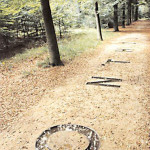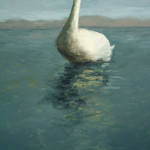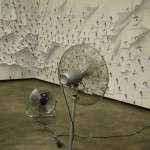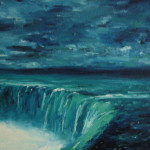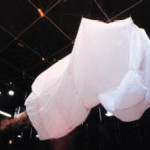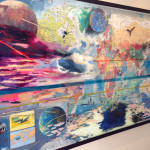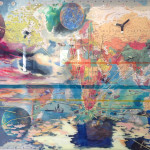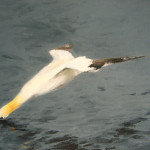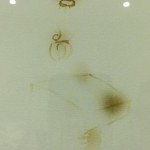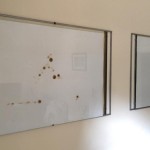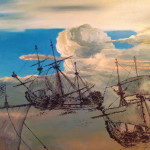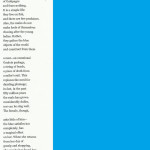The following is an unedited exchange between painters Tanya Poole and Luan Nel:
TP: You work across the board as an artist, and as much as painting seems to be a kind of home-base for you, your work varies widely in medium and content. One of the subtle threads that runs through your imagery is a sense of transience: Onthou/Vergeet allows the ideas of memory and experience to shimmer on the path before one, changing every second with the effects of weather; your birds are in flight, or are about to fly; your ships are always on the move; the waters of the Zambezi are unstoppable. Could you talk more about this?
LN: A sense of transience.
I have heard the term transience used in relation to my work a number of times. Others that have been mentioned and are possibly similar are – mutable, ephemeral and sometimes simply ‘filled with movement and ambivalence.’ I can’t say I consciously go out of my way to make my work wobbly but it is perhaps this state of movement and change that I value most. The works have no definite answers, no finite meaning and there is no stasis, the work is never totally finished saying it’s statement. I prefer leaving the gate ajar as it were but hinting at and pointing to a resolve or a meaning. Often there are multiple interpretations possible. I don’t try and confuse in fact I try and be as clear and direct as possible. They come out transient all by themselves. In that sense they are all failed attempts at clarification and explanation, at making an idea concrete. I find I am often drawn to Ephemera. The Milk drawings I did in 1998 and subsequently is an example. I fill a large sheet of Fabriano with drawing, with narrative. These are applied by literally painting in milk. Then I introduce some chaos by holding a candle at the back of the work. I have a certain memory of what images sit where but mostly it is like catching shadows. Futile. They always jump away. But in some areas the milk on the page, now dry, basically cook from the flame and as it turns brown, it reveals some drawing. I only burn a few spots, so much of the story remains there, locked in time. The meaning is there, we just can’t see all of it all at once.
The many different types of form and/or mediums I employ.
I finished my University doing a painting major and have always viewed myself as essentially a painter for no other reason than that being what I am schooled in. Had it been years spent in the Printmaking studio I would call myself a printmaker. I use painting as a base where ideas get tested and it can also be an end destination in and of itself. Painting has that ability and I take advantage of it. There may be long stretches of no painting but more sculptural work, then I simply turn around and paint again. There is no battle of the mediums for me, I use whatever best suits what I am trying to say at the time. My work is at its core idea driven. I rarely start a painting without having a reason and without having some idea of what it is I am after at the time. I think that would be pointless. From an initial idea, things develop, often only chrystalising towards the end. Sometimes not completely. If a work demands bronze, I will find a foundry and have a bronze cast. If I can do the work myself, I do, otherwise I outsource. I hold the craft of making something in high esteem and take pride in making something by hand, by myself, but it is and remains the method, not the meaning and thus if needs be, can be done by a factory where applicable or a craftsperson or technician. I believe this is why people find it confusing that I do both work manufactured, also different media and then easily start painting again. For them painting is something else. It is a craft and a skill but most importantly it is also a signature. It can be done by only the artist. This is seen as lifting it above and beyond works employing no easily identifiable signature. It is painting’s biggest block and Achilles’ heel I believe. Causing a great rift between it and other media. I ignore this rift, as much as I can. I do NOT buy into the paint romance. I think it has done painting no favours and kept painters in an isolation sometimes akin to that employed in an outbreak of bad breath. That said, I do NOT wish to make this issue my noble quest. It strikes me as futile, serving no practical or useful function. I remain resolute in my decision to have choices and not fit any one mould.
TP: Mappa Mavis: so rich! Could you talk us through your process of thinking and making of this complex piece?
LN: Mappa Mavis.
This work can be read as a development in terms medium as well as certain thematic strands I have been exploring prior to the commissioning of this work. Once this lineage is shown I will explain how it differs and how it becomes something all its own.
Since around 2012/13 my painting had started moving away from the, current at the time, theme of birds, birdlife and all things bird. It shifted toward the aquatic. Unlike the previous strands this one was not rooted in a single poem or other literary source but had a slightly more natural or organic start. I felt like painting water and less sky. I decided to keep it this open and called it The Poseidon adventure. Named after the Roman god who ordered his soldiers to go attack the sea (of Poseidon) in order for him to ascend the throne. They stabbed the sea but it did not hurt the sea whatsoever. It is a perfect metaphor for things futile. Then this title is also a quotation or a lifting from the disaster film by the same name, in the 70’s. The time of my earliest childhood. Formative years.
With that as framework, I had enough room to speak about almost everything. Both personal but also wider, historical and social terrain could be covered within this.
During this time I was participating in an exhibition that formed part of the Cape Town World Design Capitol program and asked to paint under the curatorial statement, Re-imagine Cape Town.
All participating artists were given a large glass framed board and instructed to work on something to go inside it. I had little time to have a stretcher made to fit the frame and decided to paint straight onto the glass. I painted Table Bay and then also drew one of the ships that ran aground in Table Bay in non permanent marker. The qualities of the medium used carried metaphorical significance. The fact that it was ‘unstable’ and non permanent was very important – it hopefully referred to a state of being, trying to say that we are all temporal in this place.
I continued working with nautical iconography and working on glass for a while. The ships of the Dutch East India Company held my attention. It of course deals on a personal level with my own ancestry. They were French Hugenots who fled France due to religious prosecution. They went to protestant countries like the Netherlands, who in turn sent some to their new territories and colonies, the Cape being one of them.
On a broader scale they simply referred to colonialisation, a process that has wrecked havoc and undue misery on this continent. I am tied to that by birth. Again, I leave no solid answers, they are rendered quite carefully and aesthetically pleasing. My relationship or feeling about this history is multi facetted. I would for one not be here were it not for these vessels yet it has also left immense shame in its wake. A complex subject for me to deal with as an insider, and a white Afrikaner male. 1st born no less, carrying the family name Willem Johannes, the French Hugenot, I am descended from was Jean Guillaume (John William).
One wash and this is all gone.
Whilst doing my project looking at the ships, and working in glass the Everard Read Gallery Cape Town planned a new group exhibition called EMPIRE to be curated by Emma Van Der Merwe. This could not have come at a better time for me. Here was an exhibition asking artists to explore something I was actively looking at right at the time. It seemed purpose made for these works. There were also suggested fields to explore and one was looking at empires of today, and alternative forms of empire like Facebook.
I am extremely active on social media, Facebook in particular and this of course sparked incredible interest in me. I knew and partly belonged to this empire, Facebook. But I also thought about the Fiefdoms ON Facebook. There are many. Here too I had an empire almost too great to ignore and that is the Facebook Western Cape Phenomenon – Mavis Vannie Lavis. This persona was my long time Facebook contact and I her subject. It was right then that I decided to shift my focus from my familial or ancestral origin and our colonial history to an ‘empire’ I felt part of and that I felt welcome within. This is Mavis Vannie Lavis. A complex creation that allows anybody a platform as long as they leave their prejudice by the door.
I need to explain my very intimate use of social media and how it came to be the way it is firstly. This would also explain why it was in a way foreign territory I was stepping into by pointing my gaze towards this platform for this project. I am lifting from my introduction to the Mappa Mavis:
(in November 2011 I had finished opening my solo exhibition for Brundyn + at Wembley square in Cape Town)
Afterwards we went to dinner and then home. I still stayed up talking to friends and my neighbour and then quite late went to bed. I could not sleep so decided to go downstairs and make tea. We lived in a loft in the CBD/Bo-Kaap. I had a staircase put in that I thought rather chic in design, it’s simplicity. It consisted of slats against the wall going up to the mezzanine which was also the bedroom. It had no railing, how modern!
As I went down the stairs in my socks in the dark I slipped and cracked open my skull. I was out, blood and matter was coming out of the back of my head. My partner Neil woke from the loud bang that was my head hitting the stair and rushed to my side. He held my head together in his hands. He saved my life.
The brain surgeon would not operate. He told Neil to let my family come from Joburg. Five hours after the fall the doctor decided he will try and do what he can giving fair warning that should I make it I will be severely handicapped. It was a five hour long operation. Knitting me back together again. Then they waited for days for me to respond, to wake from the coma. And three days later I opened my eyes. Expecting little, it was a great relief all round when I spoke.
Recovery was long and finally complete, or as close to it as I will ever come. It was during that first month in intensive care, locked away from everybody, only seeing a few, that I learned how social media can be a window onto the world. I had turned a tight corner at deaths door, I feared communication and contact not at all.
I now use the platform of Facebook in a variety of different ways. I had problems with my memory, I had lost a lot of ‘data’ and this Facebook helped me rebuild my timeline by giving me a timeline. I also use it as a type of diary and I also use it to publish. I write and read far more than ever before. I document my work on it, I conceptualise ideas on it and I meet people on it. It was in a post of my friend Lynette’s that some lady with the most improbable name complimented me with a word I had never known – poenankies. I knew it meant something special. Some Cape Afrikaans I had never heard but could strangely understand. This is when I befriended Mavis Vannie Lavis and discovered many new worlds through her.
For the purposes of this exhibition I decided to look specifically at this profile. It was fascinating to me that this lady, who works as a maid for some Afrikaans doctor could have such a diverse and large following. She talked to celebrities, stars in exactly the same way as she would to somebody selling newspapers, I was in awe. Here was a person, or perhaps rather a persona, who was capable of cutting through the manners, the pretence and the carefully placed guards. We became friends and I am still discovering so much through her. My world has grown immeasurably since that hospital bed. Not so much because of Mavis, but because she could now enter my space, and I hers. This thing broke barriers like nothing I had known before.
So I decided to do with this phenomenon called Mavis Vannie Lavis what all Empires do when they grow to be a certain size – map it and eventually have a Census. I have decided not to leave this data in cyberspace but rather to make something. A bit like those maps made by the early explorers. Much of which is pure fantasy and it often has a fair amount of allegory.
I map to show how I understand something of her empire.
Having spent considerable years building Mavis Vannie Lavis resulted in a very dense, rich empire for me to explore. I looked at tallying her humanitarian solutions, political diplomacy or lack thereof, and personal histories all interwoven. It is not possible to list or portray all but I attempt to touch on most where I can. The scale of this endeavour makes this an ‘epic’ piece. It touches broadly on a wide area, a vast empire.
I am honoured she plays along, so now I call her HRH. She humours me and it flatters her, Queen of it all. We are hoping this to be simply the start of our collaboration, there will be more projects.
Please read her public posts, it goes some way in showcasing her wit, her diplomatic agility and her very human scale.
She speaks in a Cape Flats accent and mainly in Afrikaans, it is untranslatable for Bing, Facebook’s favourite translation application. This means her words are often dressed in an invisibility coat. She gets away with an incredible amount. If only they knew.
Poenankies
TP: In another artist’s hands, some of your content may come across as ‘sweet’, but you not only imbue your images with poetic lyricism and tenderness, but load them with metaphorical significance. Could you unpack some of your ideas around your abiding fascination with birds?
LN: My content, sometimes I use ‘sweet’ content.
Some content might seem sweet and I hope as you say, I manage to steer clear of a simple gift card kitsch sentimentality. It is indeed a very fine line I sometimes tread and I am fully aware of it. When I was a younger artist I the syrupy stuff would fortunately get crushed when I would paint on incongruous objects from a factory yard. It was never just excuses to do the sweet stuff I must emphasize. The objects were laden with meaning.
I also do not believe one should go out of one’s way to avoid painting things like sunsets, birds or flowers. I draw the line at clowns. Clowns would be difficult to do.
I also battle with the near addiction that contemporary art has with stunts like shock and horror. It gets the attention but without substance these work can easily read hollow or at the most gifts the reader one sentence. I am not of the ilk to go tell my own or anybody else’s story and overworking the victim aspect. That phenomenon also curries favour with critics and academia in desperate need of a moral code, compass or the look of having such. I find this cynical in the extreme. This the reason I would do a work on say Mandela, with great difficulty. I have seen the abuse and it sickens.
Give me the sweet content, I will try my best to produce meaning that lingers, and that does not look down on, or from any high ground, upon my viewer. I almost view it as a challenge.
I hope to make work that draws the viewer, that almost spooks the viewer or audience a bit. Not render them stunned with guilt. Whole careers have been built using last said tactic. Again, it is a cynical point of departure, I can’t.
I also love beauty. I want to make beautiful things. I have come to notice, most work that shocks, horrifies and hurts an audience, often, almost always, is work produced by the most boring and uninspired souls. It makes sense, they are barren and the only way to grab the viewer’s attention is to damage him or her.
Another way of looking at this is to ask a real victim or person in dire straits to show you a picture, or draw one, no matter whether they are artists or not. Chances are, they will go out of their way to hand you something that will make you smile, or something that might come across as insanely cheerful considering their position. So who gives you the artist the right to steal their misery, their pain and make A R T.
Pure arrogance.
I apologise if I veered a bit off, it is however intricately tied to my choice of content.
My abiding fascination with birds.
This is difficult to explain for me. I find the birds simply enter and then leave again. It was not really planned that they will one day read as recurring iconography.
It turns out that that is exactly what has happened though. I can attempt tracing things back.
In 1991 I was in second year at Wits University doing a BA Fine Arts Degree with English as my second major. Having had an Afrikaans schooling up until University I felt slightly insecure when it came to deciding on which area of English I wanted to focus on, the choice seemed obvious to me. Between Middle English and American literature I of course chose the latter.
It is in this course that we studied American verse and I read a most interesting poem by James Tate called The Blue Booby.
This poem was not studied by the group in second year, I came across it within our reading material for this course. It struck a chord and I kept it always, read it many times.
What I found so beautiful is the comfortable use of sublimation. The author describes the life and habits of this animal in the voice of a wildlife documentary orator. I could almost imagine Sir. David Attenborough’s voice reading this.
In the beginning one goes along with it and then as the poem continues the language gets more descriptive of human states of being, the habits become too bizarre to belong in any wildlife doccie and you soon realize this had nothing to do with Ornithology and everything to do with grand issues like, love, death, ownership, materiality, sexual identity, gender roles, states of attraction and compromise
I liked the mechanics of this poem. How it could use a relatively simple and sweet tale of two birds and make it speak of the human condition.
I did not immediately drop everything I was painting or making and start painting birds. It was more a case of them popping up somewhere suddenly.
One such occasion was for a city wide urban arts program called – Urban Futures
It took place across Johannesburg and was mainly concerned with urban planning, architecture and public spaces. Art was one component in a larger framework.
I wanted to replicate the city pigeons found standing on top of public sculptures and found all over any large city. I wanted them done in bronze, because of the reference to public art but mainly because it is a semi precious metal. This is the reason why so many bronzes have been disappearing from their plinths in our public spaces.
I was at the time looking at the idea of ‘loss’ in the broader sense. Loss of innocence perhaps, the fall of man, every culture and religion has such a narrative wedged somewhere within their dogma. These pigeons could also be seen as my birds of paradise. What I needed them to do, is leave ‘paradise’ thereby creating this absence, and the sense of loss. By making them bronze I was assured that all my birds, no matter how well epoxied they were to their terrain, they all ‘flew’ the coup in just one night, the same night of the installation day. They were of course stolen to be sold as scrap metal. Inner city crime finally also had a positive if poetic function, it created flight and I view it right next to bronze as a medium.
What can speak clearer about absence, loss, than theft. A Perfect medium for this purpose.
Birds have been in and out my whole body of work since the beginning but there is a period of focus, most recently. From 2011 until 2014 I worked solely with bird iconography or bird related content. I felt it time to look at the poem, almost as if for the first time and see how I could achieve a similar sublimation.
In a way the point of departure was pure copying, I too will be doing portraits of birds, telling facts about their mating rituals and their habitat, only in my case it will not be one work but many and of course it will be visual although it must be said that meaning definitely also resides in my titling.
I would say somewhere between the title, the image and what is given information and folklore or metaphor related to some birds, my message or attempt at structuring a sentence, lies.
I use this ONE subject matter to make art about anything. In this sense it more closely resembles language. It is as much a theme (in the broadest sense) iconography, and content as it is discourse. It is a structure within which I can talk, describe situation, relationships, politics , anything and at the same time – enjoy painting. It serves as a carrier in this way.
This three year period saw three main exhibitions.
It started with Aviary at Brundyn + Gallery in 2011 (an exhibition of watercolours)
Then SWALLOW at Nirox Maboneng in Johannesburg in 2012 (an installation piece)
And finally Twitter at the Everard Read Gallery Cape Town in 2013 (Mainly an exhibition of Oil on canvas work but also a large format edition of 20 Lithographs)
The idea for this work started forming long before I started the three bird years. I can not give an exact date. It might have been as early as when I did the Urban Futures project, 2001. The work is a good example of a work of mine that sits with parts in different media but reads as one work. I started by doing four watercolours of a swallow in different stages of flight, this on A3 paper.(painting employed as medium) I then had about a hundred or more of each painting photocopied (creating the flock) and one could say (print making?).
(Then installation) I stick these papers in an overlapping fashion on the wall. Size in total depends on the space given or selected. I then have one or two industrial fans, ideally placed far away, blowing whilst oscillating. This causes the paper to flutter making it seem like the motion of a flock of swallows flying. The title is simply swallow in capitols, which hopefully sets it apart from simply swallow, the bird. It now also can imply an action – to swallow something down one’s throat (oral sex comes to mind) and a command (doctor’s instruction and possibly again a sexual undertone seems manifest.
It also by its iconography speaks of change/ migration and of flight. Flight is often linked to ideas around freedom and escape.
note that swallows always return.
Somewhere within and relying on all the above, the work resides.
TP: All four of us in this set of interviews come from quite different backgrounds, languages, cultures. All four of us grew up in South Africa under Apartheid and all of us use painting as our primary medium. I’d like to be able to give non-South Africans a sense of what it means to be a South African artist. Could you talk about some of your work in this context?
LN: To be a South African artist – Now
Pa se tent
Work is rarely isolated from environment and my work is certainly no exception. Although often speaking from memory my work also reflects collective memory.
In my work Pa se tent done for the exhibition Taking Stock during the 2nd Johannesburg Biennale I was looking back at the construct that was the white middle class suburban dream. Called ‘Pa se tent’ again has pseudo sexual references to an erection. Indicating the general patriarchal bias of this dream/construct – as a child, when you have an erection, it was euphemistically called to make a tent. The work consisted of a near full scale replica of the house I lived in with my father in Verwoerd Park, in Alberton. The suburb’s name should indicate the where alliances lie in terms of our Apartheid history. This is about a white place. The replica was done in the form of a large inflatable, in white. I used the technology of the children’s jumping castle. It was hoisted up into the air, suspended. This also a reference to – building castles in the air. An opinion on the false reality we were living. The work also ‘breathed’ in the sense that it was set on a timer, inflating then deflating at regular intervals. This also again references ‘erection’
On a more intimate level it speaks of my relationship to the patriarch of our family, my father, and the ideals set out for the son, me, of how to continue the white Afrikaans male hold on power. It hopefully reads not as glorification but as every evidence of a false inheritance.
Onthou Vergeet
This work led directly from ‘Pa se tent’. This is how I would trace a development of a theme.
I was invited by Fundament foundation in The Netherlands onto an exhibition in a restored baroque park in Tilburg The Netherlands. It was to be an open air exhibition. This took place in 2001 and was called Lustwarande – Pleasure Garden, I was one amongst a selection of international artists participating, including Louise Bourgeois, Michaelangelo Pistoletto and Frank West.
I looked at the idea of the white middle class house again, I use it as a metaphor for the Apartheid dream. Perhaps a better phrase would be the Apartheid master narrative.
I wanted to dig the foundations of this ‘house’ into the Dutch soil. This comes with its own mild accusatory nuances. Site matters. Then I took it further and thought to fill the foundations with water, making them reflective, thus visible, but also useless – reflecting again on a failed system (Apartheid, patriarchy)
That to all intents and purposes was to be the work. But then it occurred to me that this is all using my memory of our society or country and my personal family history…. And all has to do with accusation, assigning guilt, judgement, and was veering towards the kind of easy moralistic self aggrandising post apartheid work I so loath.
Fact is, I was trying to grapple with my identity and my heritage in the most honest way I could, through recalling how things were and holding their image up for scrutiny.
This was when the English saying, and it exists in Afrikaans too, Forgive and forget, came to mind.
I thought instead of the foundations, write these words.
Then decided I could not do that. It would be as if I was asking or telling people to simply forgive and forget and knew it to be impossible to forget.
I then worked with the binaries of ‘Onthou’ and ‘Vergeet’ throwing ‘vergewe’ out because I realised the viewers would complete the sentence with vergewe (forgive) in their minds and then realise this is slightly different. Instead of ‘forgive’ the word ‘remember’ is used.
This can lead to various different interpretations. I am aware that some would read it as asking people to remember and then forget something. Written in Afrikaans within the international exhibition, links will occur between our specific history, and then of course the Afrikaner’s hand in this.
It is necessary to make the viewer realise I am not saying people should forget. I am merely placing the words in binary positions and filling them with water. Thus creating mirrors letters in the soil. Reflection is key.
The literary device of the Conceit is being employed. Even by placing the words the way I did, one realises it is impossible to forget, to wipe clean. In that way the word ‘vergeet’ fails us.
Luan Nel is an artist currently living and working in Cape Town South Africa. He received his Ba-Fine Arts degree in 1993 and a higher diploma in Education (post graduate) in 1994 from the University of the Witwatersrand, Johannesburg. In 1993 he also received the Judges prize in the Sasol New Signatures Competition. He started working professionally as an artist immediately after finishing his studies at university. In 1998 and 1999 he was awarded a residency at the prestigious Rijksakademievan Beeldende Kunsten in Amsterdam, The Netherlands. He also did a short research residency atThe Dutch Institute in Rome in 1999. Work resultingfrom his time in Rome was acquired by TheSasol Collection and currently on permanent displayat their headquarters in Johannesburg. This isone of various Corporate collections featuring Nel’s work. Others include, Absa bank, SABC – theSouth African Broadcasting Corporation and HollardInsurance. Academic collections include TheUniversity of The Witwatersrand and The Rijksakademie van Beeldende Kunsten. His work was alsoacquired by The Johannesburg Art Gallery. Nel’s practice focuses on painting and installation, oftenin combination. In 1996 he did a very ambitious project CENTRE in the abandoned parking lot of TheCarlton Centre in the CBD in Johannesburg. This one-night event attracted hundreds to city centre, something many thought impossible. He does not onlydeal within the sphere of artistic interventionbut also the more private space of the studio. Nelhas exhibited locally with The Goodman Galleryand most recently (April 2013) a large solo exhibition with The Everard Read Gallery in Cape Town.He has been on various group exhibitions and in 2000 he had the honour of exhibiting amongst suchicons as Louise Bourgeois and Michelangelo Pistoletto in Lustwarande, Pleasure Garden. This was inTillburg in The Netherlands, curated bu Mariane Bruwer and Chris Driessen. In 2013 Nel was chosenas Young Curator 2013 curating an exhibitionWeerberig – Weather Reportfor the Aardklop ArtsFestival 2013 (One of the large Arts Festivals in South Africa) This exhibition showcased 26 artists’work dealing with issues around ‘land’ like ownership, nationalism and climate.
